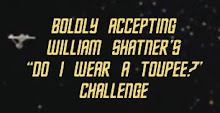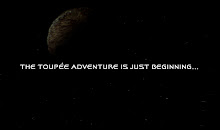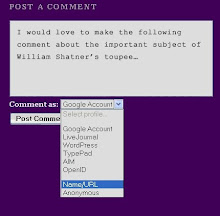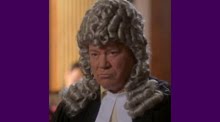
We've often compared the study of Bill Shatner's toupee-wearing to the 1970s Watergate scandal. Both involve the seeking out of intriguing and seemingly endless threads of information, which ultimately coalesce around a single unmistakable premise. In this post, we'll stretch that analogy a little further. One aspect of the whole Watergate affair was a notorious 18 1/2 minute gap in the Nixon White House tapes. What was on them? Why did Nixon risk his presidency by possibly wiping incriminating evidence, which was being subpoenaed in a criminal investigation? Does not the gap itself add to the picture of intrigue and even guilt?

In the ongoing investigations into Bill Shatner's toupee-wearing, we find something akin to that missing 18 1/2 minutes. But in this case, the gap is even longer - a full thirty minutes of what we believe to be toupologically crucial time for which Bill Shatner has not, and, dare we say, cannot account without conceding the full truth about his toupee usage! We present the case:

On page 102 of the 1993 behind-the-scenes book Star Trek Memories, author Bill Shatner described the makeup process, which fellow actor Leonard Nimoy had to endure in the 1960s Star Trek TV series in order to transform himself into the Vulcan Mr. Spock:
By about six A.M., Leonard had already reported for work and could generally be found relaxing in Freddie's [Fred Phillips was the series' makeup artist] barber chair, stinking up the makeup room with his fried-egg sandwiches while Phillips proceeded to turn him into a Vulcan. First Freddie would shave off the tips of Leonard's eyebrows, leaving just the inner third on each side. Then he would whip out his trusty spool of yak hair (yes, I did indeed say "yak hair") and glue the upswept edges of Spock's brows into place. The ears would go on next, followed by a quick dusting of pancake and a final once-over in the mirror. When the look had met with Leonard's approval, Freddie would move on to the rest of us.
Setting aside the implications of Bill Shatner talking about glue and yak hair, let's instead focus on several key points relayed above - Nimoy: one hour; the rest of the cast: in, out, straight to the set...
But something here doesn't quite seem right.
Charlie Washburn, who sadly passed away this April, served as assistant director on Star Trek. And, as noted by Memory Alpha, "Washburn [was] the first African-American who applied, and then graduated from the Director [sic] Guild of America." Back in 1986, Washburn penned a (very interesting) article for the sci-fi magazine Starlog proudly and nostalgically reflecting on his work in the legendary series - this article was recently posted by the blog My Star Trek Scrapbook to mark Washburn's passing.
In one section of the article, Washburn manages to walk a very clever, and dare we say classy, tightrope by revealing a crucial nugget of toupological information without actually overtly doing so or dwelling on or expanding upon the inference. As with the segment from Star Trek Memories, this part also recalls the makeup process involving the cast and Fred Phillips:
The reporting times for our main cast almost never changed. Nichelle Nichols' and Leonard Nimoy's reporting time was 6:30 a.m. to be ready for an 8:00 shoot. Bill Shatner's was 7:00. And DeForest Kelley, George Takei, Jimmy Doohan and Walter Koenig were all expected at 7:30 since their makeup requirements were minimal.

Let's go over and try to expand upon what Washburn is saying here:
-Leonard Nimoy as the pointed-eared Spock: considerable makeup requirements, reports at 6:30 a.m.
-Nichelle Nichols as Uhura: heavy female makeup and also wig application, reports at 6:30 a.m.
-Kelley, Takei, Doohan and Koenig: minimal makeup requirements, report at 7:30.
But Bill Shatner reports at 7:00, a full thirty minutes before those with "minimal" makeup requirements were needed in the makeup room. This begs a very simple question:
Basic math can help us deduce the most obvious possible answer. If prosthetics (1 hour, Nimoy) or heavy makeup (1/2 hour) and a wig (another 1/2 hour, Nichols) require a full hour more than "minimal", and if we know that Bill Shatner wore no prosthetics (1 hour) or heavy makeup (1/2 hour), then there is only one logical conclusion - the extra half hour was required for Bill Shatner's toupee to be applied.
Thus, the actor did not simply rush in and out of the makeup room, but rather was there for a full thirty minutes each day having his toupee applied (including gluing the lace line at the top of the forehead and then covering it with pancake makeup). Only then would he, along with Kelley, Doohan, Takei and Koenig undergo the relatively quick process of applying makeup to the rest of his face (this is done to prevent harsh lighting from "bleaching" the skin and also to absorb potentially reflective sweat).
In his clever use of language (evidently balancing loyalty to those actors he worked with against the importance of the toupological historical record), Washburn essentially suggests the above conclusion without directly saying it. It's circumstantial, but what other possible logical conclusion is there? Bill Shatner might have wanted to arrive on the lot early for a number of reasons, but a makeup call is for one reason only - to apply makeup. Thus, once we have eliminated the impossible...
As many of the behind-the-scenes folks from the original Star Trek gradually leave us, we can't help but be eternally grateful for any nugget of shared toupological knowledge regarding their historic and historically significant contributions to a television series in which Bill Shatner's toupee-wearing was and continues to be a central, if not the central, component. There's still so much of their work to be done in the galaxy...
Thus, the actor did not simply rush in and out of the makeup room, but rather was there for a full thirty minutes each day having his toupee applied (including gluing the lace line at the top of the forehead and then covering it with pancake makeup). Only then would he, along with Kelley, Doohan, Takei and Koenig undergo the relatively quick process of applying makeup to the rest of his face (this is done to prevent harsh lighting from "bleaching" the skin and also to absorb potentially reflective sweat).
In his clever use of language (evidently balancing loyalty to those actors he worked with against the importance of the toupological historical record), Washburn essentially suggests the above conclusion without directly saying it. It's circumstantial, but what other possible logical conclusion is there? Bill Shatner might have wanted to arrive on the lot early for a number of reasons, but a makeup call is for one reason only - to apply makeup. Thus, once we have eliminated the impossible...
As many of the behind-the-scenes folks from the original Star Trek gradually leave us, we can't help but be eternally grateful for any nugget of shared toupological knowledge regarding their historic and historically significant contributions to a television series in which Bill Shatner's toupee-wearing was and continues to be a central, if not the central, component. There's still so much of their work to be done in the galaxy...


























